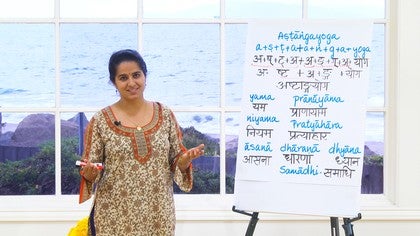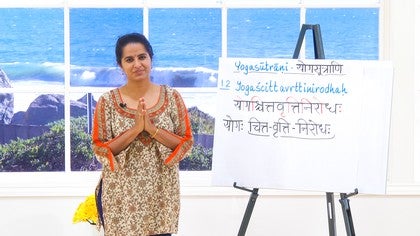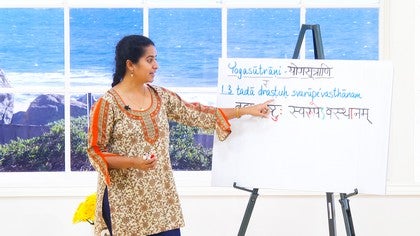Description
About This Video
Transcript
Read Full Transcript
Namaste, kushalam, all well. Kushalam is the Sanskrit word to ask if everything is fine. And then you can answer aam, kushalam, yes, all is well. Or na, na kushalam, not very fine. But we prefer the first one of course.
I hope you have been following me on these lessons on how to read and write Sanskrit. We have seen how the letters are written out, how they sound. And then we have been trying to combine them together to see what the words would look like. We also mentioned that in Sanskrit the words can be slowed down and broken up into their individual syllables, which then get represented by different letters or different aksharas that are represented in the Devanagari script. So we look at a word that you are all very familiar with in the yoga tradition.
It's the ashtanga yoga. The ashtanga yoga here refers to Patanjali's eightfold limbs. And the word itself can be broken up into the different components which are a, sh, t, a, n, g, a, yo, g. You must be wondering why I have got two a's in there. That is because the term ashtanga yoga can be broken up into three words.
Ashta, which is just what you see there. Anga, which means limbs. And yoga, yoga. So we have ashta, anga and yoga. We had seen how the term yoga is brought together in our previous lesson.
So here I have just put it there together so that you are already familiar with it now. Now we have ashta. So we have the vowel a and then we have a combination of consonants. And the vowel a. So we have this sh and t come together to form this composite letter.
Sh, t. The t has the dot below it which indicates that the letter is from the cerebral group. So you have ash and the half tomato. Remember we spoke about it. So that's ash, t.
And because it has the vowel a, it doesn't have any extra symbols on either side or below it. So that's ash, ash, t. What I would like to just point out to you and when you look at the set of letters together you can pay attention to is that in Sanskrit we have three sibilants or three sh sounds. We have the sh, the palatal sh, which is the cerebral sh and the s, which is the dental s. Now the question that arises for many students is how do we know which sh to include in there?
Sanskrit being a very phonetic language helps us figure this out for ourselves. So the logic is such, when you hear the sh sound, pause and see what the following letter is. So we have ash and then you have the t. The moment you have the t, then you know that the letter that came before it or the sh that preceded it has to belong to the same group of pronunciations. I'll say that again.
So the t belongs to the cerebral group of letters. As a result, the sh which precedes it has to also belong to the cerebral group of letters. So it will not be the asta, which is the dental s. It will have to be this cerebral sh. So you get ashta, ashta.
Try saying that once, ashta. Now just for the play of it, try saying the s sound instead of the cerebral sh. So say asta and you will find that it's not easy to do that. So what flows naturally is the combination shta belonging to the cerebral group. So keep that in mind.
It's a small tip, but it's a useful one. So we have ashta and then a g. So you have a g. Now I need to make a small correction there. The g has to have the line below it to indicate that it is the g, the phoneme g.
So a, n, g, a. Now n, g, a will give you n, g. And because that has a rounded bottom, the letter g comes below it. It gets squished a little bit and allows the g to come under it. So ashta is that is getting clearer.
So we have a, n, g and the word yoga. Another small note to observe here is that as you had the combination shta. In Sanskrit we also have the different nasal sounds. You have n, n, n, n, n, n, n, n, n. So, when writing out the nasal combination with another consonant, there is always an element of doubt.
Which nasal should I include there? The logic is again simple. Fall back on the phonetics of the language. Look for the sound that follows it. So you have the l, hold, go to the next letter.
It's the g which belongs to the guttural group. So the nasal sound that will come before it will have to belong to that same group of letters. So you have n, ng. It would be very difficult to pronounce ng, for example. Every nasal sound belongs to the same group of the letter that follows it.
It belongs to the same group of pronunciations. Okay, I hope that is... You will see it more often and then you will understand it better. So here we have this whole sound, ashta, anga, yoga. Now when we look at the original word, we have ashtanga yoga.
There is a lengthening of the vowel u. That is what we call in Sanskrit the euphonic combination or the sandhi. Phonology is when you put two sounds together, there is a slight modification and a new sound emerges at times. So we have ashta, anga. Now say that really fast, ashta, anga, ashta, anga, ashta, anga.
You will see it tends to become ashta, anga. And the long vowel a is represented by this extra stick there. So you see this disappears, it becomes a long sound and it becomes a stick there. So we have ashta, anga, yoga. You want to try saying that?
I will just point it out letter by letter and see if you can start recognizing the formation of that letter, alright? So ashta, anga, yoga, together ashta, anga, yoga. Just don't forget to add that dot there. That dot is what makes it the nasal nna. If it is not there, it becomes the duh which is a different sound, okay?
So there we have ashta, anga, yoga. Now let's move on to the eight limbs of this yoga. They are words that you use often and I think it would be nice to see what it looks like and also to try and get the correct pronunciation as far as possible. The key is always abhyasa as they say in the, in the ashta, anga, yoga text itself of the yoga sutras. The more abhyasa or the more practice, the more perfect it will become.
But I won't worry too much about it and yet be open to the truth of the sound, yeah? So let's go for it, yama, niyama. That's what it looks like, niyama. Then asana, okay, there's a small mistake there. We tend to also pronounce it sometimes as asana but actually there is no long vowel at the end of that word.
It's a short vowel. So we'll make a small correction there. This dash on top would make it the long sound like aa, sa, na. To make the vowel short, we have to take out this dash there and that would make it aa, sa, na in diacritical but we have to make that corresponding correction also in the devanagari. This is a good place to show how you do it.
So you take this out, yeah, and that is aa, sa, na. The extra line that would have made it aa, sa, na but that's not what we want. So it's aa, sa, na. Now let's look at the next word which is pranayama, pranayama. The following one is pratyahara.
Pay attention to the long and short vowels because that is really what gives the music of the word and the correctness of the word as well. So we'll just see it in Sanskrit once, pratyahara. It's a half the that combines with a year, pratyahara. The next one is dharana, dharana and the corresponding Sanskrit is dharana. There are three words that follow the dharana, dhyana and samadhi that have the sound the appearing in it or the appearing in it.
Now because of the absence of these sounds in the English language, one would tend to hear them as dharana, dhyana and samadhi. You can hear the heart d, d, d. You need to soften it. You need to soften it into the soft palatal d, but add the breath and it becomes d, dharana and also draw your attention on the n which is not the regular n, the dental n of the English language. It is the cerebral sound.
So you have to put your tongue, the tip of your tongue on the roof of your mouth and say nah, dharana. Say that, uttamam, excellent. That's fast, dharana, lovely and then we have dhyana, say that, dhyana. Now try and say the way that you are used to sing it, dhyana, dhyana and then just become conscious, place your tongue out a little bit, soften your, the teeth on your tongue and say dhyana, say that, dhyana. If you can start feeling this difference in the effect of the sound, I think we are doing really well.
So here we have it, dhyana. Again the dha as you can see here in the word samadhi has the full form when it combines with the other consonant here, it drops that stick and connects to the next letter. So you get dhyana, yeah, great. Let's go on to the last one which is what we are all aspiring to do through yoga, samadhi. Try that, samadhi, dhi referring to your intelligence.
So it's not the dhi, it's the, soften it, stick the tongue out initially, dhi, samadhi and this is what it would look like. So we have the s there and then we have the m that we have encountered already in yama, you see that, m and there you go, sama, long one that we cancelled out there but we have it here, samadhi, the short e precedes it with a stick. So you have the stick and the hook on the letter, samadhi, yeah, getting it? What I normally recommend to people who are learning how to write this script and familiarize themselves with it, pick up any one letter like the mer let's say and whenever you see a Sanskrit text, see if you can spot all the mer's in that, then that will give you a connection with that particular sound and then you can try and see how they combine with the different vowels. So whenever you see the mer, look around it, if you can see any vowels and see if you can identify that individual syllable of the composition of the consonant, mer plus whatever vowel follows it.
So that, yeah, it gives you a sense of confidence that now I can recognize it wherever I see it and then you can play to learn all the other letters, fill in the jigsaw puzzle of the Sanskrit alphabet. Just for the last time, join me, we will say these sounds together, we will say them twice. So first time I will point out to the diacritical and then the Sanskrit, follow me. So you can make a shift from the Roman transliterated form to the Devanagari script, okay? Here we go, ashtanga yoga in Devanagari, ashtanga yoga, yeah?
Remove on to the different limbs, yama, yama. Next one, niyama, niyama, asana, asana, pranayama, pranayama, pratyahara, pratyahara, pratyahara, dharana, again, dharana, dharana, dhyana, dhyana, samadhi, dhyana, dhyana, dhyana, samadhi, samadhi. You would have noticed that we were really doing a slow motion form of pronouncing these words but I think initially it's a helpful practice to do so because once your mouth has got used to the sound of the language, you can say it fast and you would still say it correct. So we've done the ashtanga yoga and seen the different limbs. As you engage them in your practice or as you use them in your practice, play with the idea of getting it right for yourself and see if it makes a difference.
I'm really curious about that. Enjoy the process and see you again soon.
Mother Tongue: Sounding the Words
Comments

You need to be a subscriber to post a comment.
Please Log In or Create an Account to start your free trial.








